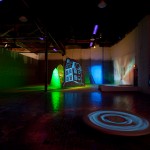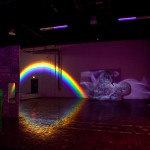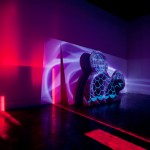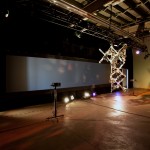From Woodstock and Pee-Wee’s Playhouse to art museum
Two multimedia artists, Joshua White and Gary Panter, are lighting up Detroit
Share
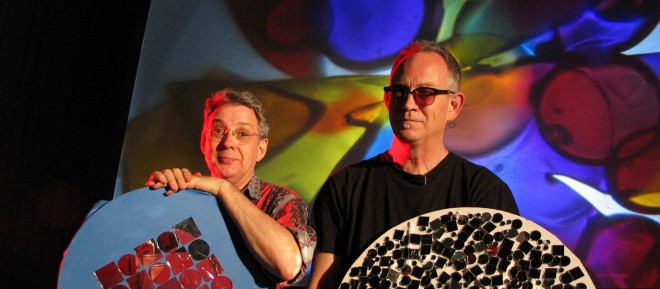
Some visual artists use paint, others, clay. But for multimedia art pioneers Joshua White and Gary Panter the material of choice is light. The New York-based duo, who’ve been working together since the late 90s, has recently collaborated on Joshua White and Gary Panter’s Light Show; a 2,044 square metre immersive installation at the Museum of Contemporary Art Detroit (through April 29).
White, a born-and-bred New Yorker—who famously performed at Woodstock and has done live light shows for The Doors, Janis Joplin and Jimi Hendrix— has a background in TV production and has designed a light show for the exhibit. Panter, a renowned graphic artist and painter best known for his boundary-breaking comics, album covers and set design on Pee-Wee’s Playhouse, has used both light and sculpture to build a “fun house of the imagination.” They’ve also invited various musicians, comedians, “mad scientists” and other artists to perform in the space. On a sunny New York afternoon, the animated duo talked with Maclean’s about light, life and the importance of always trying new things.
Q: Joshua, you’ve been doing the Joshua Light Show, where you improvise multi-media projections during live concert venues, since 1967. You’ve always had many artists in your crew, correct?
JW: I’m the leader of the Joshua light show because my name is on the door, but what’s lovely nowadays is that we all do it. There’s nothing nicer than not leading; just making sure everything is all right and letting everybody else do it. We know our instruments. It’s just like musicians. We really know how to play our lights.
Q: Is the process like a band where the guitar player always plays the guitar?
JW: We can switch up, but each person seems to have an area they’re passionate about. In the course of an actual performance, we move around and help each other. The thing that Gary and I did in Detroit—and informs what I do—is improvisation. It’s theatre games, where you always listen and never negate. It’s very important that we react and listen to the music. We don’t have to hear it ahead of time as long as we have some knowledge of it. We do some things that are similar but it’s very much a sport of improvisation.
Q: How does the MOCAD exhibit differ from the Joshua Light Show, of which Gary is often a part?
GP: The show in Detroit is an installation—rather than a live performance—by Joshua’s crew of light show artists, which often includes me. The Detroit show uses lights that are sequenced and projections of filmed elements, such as hand animations. So for MOCAD, our project runs all the time on its own. In the Joshua Light Show, or in Joshua and Gary collaborations, we usually do a live improvised light show performance that is accompanied by live or recorded music. The performance is one of a kind and is like improvised jazz. Live operators shape light elements by hand in real-time by various means, like bendable mirrors or pressure on liquid lights.
Q: And how did the MOCAD show come about?
JW: Chris Byrne, who is a friend and curator and consultant, introduced us to the museum. We had discussions with the museum staff and built models. Once the museum approved our general plan of what our show might be like, we began to make more specific models and worked with a theatrical fabricator to manufacture most of the sculptural elements in the show, which were finished and assembled in Detroit.
Q: You’re both accomplished artists and have been working together for a decade. How did you meet?
JW: I saw Gary’s [light show] work ten years ago and we became friends. I went to see it in a gallery as art and he was making something absolutely beautiful and pure. And you could fit it in a suitcase.
GP: I was using flashlights. The bigger the light show is, the more electricity you need; the more power, the bigger the lights need to be to project over farther distances. I read about Josh’s light show in the ’60s and I was stuck at home in Texas going to church. I did experiments in my house, in my garage and some of those same ideas were things we used in Detroit. For this recent show, I was able to make wallpaper that when you shine coloured lights on it, images turn on and off so it does very simple animation using complementary colours.
JW: Gary is a trained painter, I was trained in both theatre and film technology. But the thing I really wanted to do was throw light around. The problem is finding a place to throw it around. I was lucky. In the mid 60s, music and society changed. There was a revolution. People wanted more, bigger, louder more interesting music. And there was nothing to look at. So I did discotheque lighting.
Q: What was your first light show experience back then?
JW: There was a wonderful guy, Bobb Goldsteinn, who gave parties. He had a thing called Lightworks in 1966. It was a party in his loft on Christopher Street. There would be a mirror ball, four lights with colour wheels and some Christmas lighting and he would stand on a platform and dance and change the lights and then three window shades would come down and we would do slide shows, which were always pictures evocative of Summer in the City by the Lovin’ Spoonful. It would just be photographs of summer in the city and everybody thought it was this amazing multi-media work and over in the corner is Andy Warhol making notes.
Q: Wow.
JW: It got into me and all I wanted to do after that was light shows. I had a good reality base, nothing happened to me, I didn’t leave my girlfriend or start to smoke dope.
Q: Did you feel like a rock star?
JW: No, but Gary is in a band.
GP: We’re going to Detroit to play in our installation. We do a lot of covers of obscure psychedelic pop songs. It’s another wonderful thing. Being an artist, there are a million ways to express yourself. It’s fun to not just do one of those things. It’s more fun to jump all over the place.
Q: Any words of advice to share?
JW: The light show group age range includes people my age and people half my age. The secret of success in working with younger people is, you work with them and you hang with them and you drink with them but then you go home. And that’s all it takes. You have to know when to go home. It’s like the old version of how to teach art to children, you know that old trope? And I have no problem with the word “old.” Give them the materials but know when to take them away. Know when to say it’s done and hang it on the wall.
GP: I pretty much stay alone in my room and stay up all night. That’s how I work. That’s when the phone stops ringing and people stop asking me for things and I have six to eight hours to live them out.
Photos of Joshua White and Gary Panter’s light show are by Corine Vermeulen, courtesy of the Museum of Contemporary Art Detroit.
Below, an example of the sort of work The Joshua Light Show creates, from June 2011, in the Hayden Planetarium at the American Museum of Natural History in New York.
